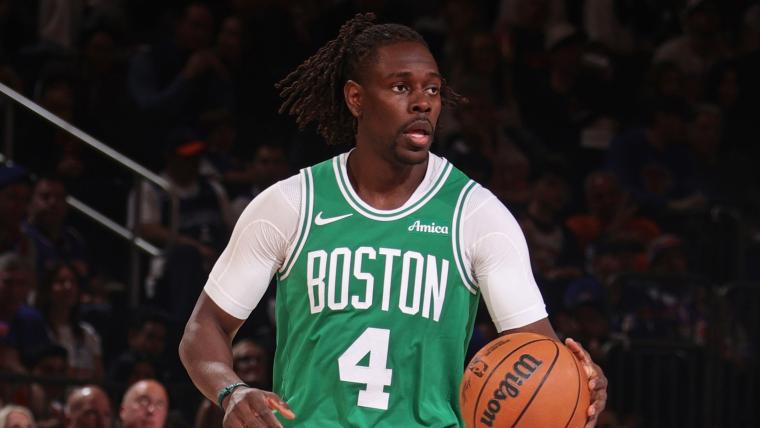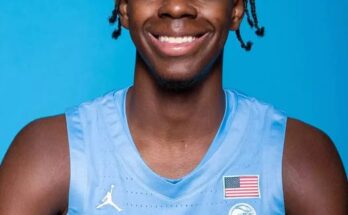On June 24, 2025, the Boston Celtics completed a surprising and, in some ways, controversial trade that sent veteran guard Jrue Holiday to the Portland Trail Blazers. The Celtics received Anfernee Simons in return—an offensively gifted guard on an expiring contract—along with what were originally two future second-round draft picks. The deal seemed straightforward at first glance, but within two weeks, the trade evolved into something far more layered. It was not just a player-for-player swap—it became an emblem of shifting strategies, medical surprises, and league-wide consequences that few saw coming.
At the heart of the situation is Jrue Holiday, a two-time NBA champion and one of the league’s most respected two-way guards. Holiday, now 35, had just completed a solid season with Boston in which he was a key piece of their 2024 championship team. His perimeter defense, leadership, and playoff experience made him a cornerstone of the Celtics’ identity. But with Jayson Tatum injured and Kristaps Porziņģis recently traded, the Celtics were facing a massive financial burden with little clarity about their title chances in the coming season. Holiday’s four-year, $134 million contract extension, signed just a year prior, was starting to look like more of a liability than an asset in a new cap environment.
Boston’s motivation for trading Holiday stemmed largely from their financial situation. With one of the league’s highest payrolls and the second tax apron looming, shedding salary became a priority. Moving Holiday’s $32.4 million owed for the 2025–26 season was the first step. Enter Portland, a team coming off its fourth consecutive season without a playoff appearance and in search of both direction and identity. The Trail Blazers saw an opportunity not only to add a proven leader but to signal a win-now mentality. Jrue Holiday had been briefly on their roster back in 2023 after the Damian Lillard trade but was immediately flipped to Boston. Now, two years later, they were finally making him part of their actual rotation.
The initial terms of the deal were clear: Portland would send Anfernee Simons and two future second-round picks to Boston in exchange for Holiday. The deal offered a blend of short-term relief and long-term planning for the Celtics. Simons, a capable scorer and solid three-point shooter, could contribute immediately and his expiring contract gave Boston future cap flexibility. The picks, while not high-value firsts, added to Boston’s war chest for potential future moves.
However, just over a week after the trade was announced, news emerged that would alter the dynamics of the entire agreement. During a routine medical evaluation by the Trail Blazers’ staff, something unexpected was found in Holiday’s physical. The medical issue wasn’t severe enough to nullify the trade, but it was significant enough that Portland reopened negotiations with Boston. Rather than risk friction or voiding the deal, the two teams came to a new agreement: the second-round picks would be removed from the deal. What had initially been a multi-asset trade was now a one-for-one player swap—Holiday for Simons.
This amendment caught many league insiders off guard. It’s not unusual for teams to tweak trades after physicals, but it is rare for draft picks—typically minor sweeteners in these kinds of deals—to be stripped out altogether after the agreement. The fact that Portland felt strongly enough about Holiday’s medical findings to push for the removal of picks, and that Boston agreed so readily, hinted at both sides’ urgency. Portland didn’t want to walk away from a player they had pursued for years, and Boston was motivated to offload salary without friction.
The Celtics’ acceptance of the new terms, especially the loss of two draft assets, tells its own story. League sources believe Boston’s front office had decided to cut ties with Holiday regardless of return. With Tatum sidelined and uncertainty surrounding their ability to compete in 2025–26, they prioritized cap relief and roster flexibility over future picks. Simons’ expiring deal not only freed up space in the future but gave the Celtics a young, athletic guard who could fit in either as a stopgap or long-term piece depending on how things played out.
For Portland, acquiring Holiday was a calculated risk. They now have a highly respected leader who can stabilize a young team and teach winning habits. His championship pedigree is undeniable, and even with some health concerns, his presence alone shifts the team’s culture. But there are questions. At 35, Holiday has already peaked physically, and last season showed the first signs of real decline. He posted his lowest scoring and assist numbers in over a decade and was left off the All-Defensive team for the first time since 2020. Those signs, paired with the medical red flags, add an element of uncertainty to what Portland hopes will be a transformative addition.
Privately, it’s been reported that Holiday was less than thrilled about the trade. He had grown comfortable in Boston, felt valued as part of a contending group, and enjoyed the stability of a defined role on a veteran roster. Being moved to a rebuilding team, even one with playoff aspirations, came as a disappointment. While he’s known for his professionalism and team-first mentality, sources say Holiday was “pissed” about the trade and viewed it as an abrupt end to a promising chapter in Boston. Nevertheless, he’s expected to fulfill his obligations in Portland with the same integrity and defensive commitment he’s always brought.
From a basketball standpoint, the fit is intriguing. Portland has young scoring talent in Scoot Henderson, Shaedon Sharpe, and now Deandre Ayton in the frontcourt. What they’ve lacked is veteran leadership and defensive organization, particularly on the perimeter. Holiday provides both. While he may no longer be the offensive force he once was, he remains one of the league’s smartest defenders, and his experience could accelerate the development of Portland’s young core. If the Blazers can stay healthy, this trade might elevate them into the play-in conversation, and maybe more if the pieces click.
For Boston, the focus now shifts toward the future. With Simons likely to play a prominent offensive role and his deal set to expire, the Celtics can retool depending on how the season plays out. If Simons thrives, they may consider extending him or flipping him at the trade deadline. If he struggles or doesn’t fit, they simply let the contract expire and enter the 2026 offseason with considerable cap space and flexibility. Either way, Boston avoids a long-term financial burden and opens the door for younger players to step into larger roles while they wait for Tatum’s return.
Strategically, the trade reflects two opposing philosophies. Boston, recognizing the limitations of their current window, is taking a step back to set up for another leap forward. Portland, tired of being stuck in the lottery, is making a bold attempt to leap into relevance now. It’s a classic case of asset management versus ambition. Only time will tell which approach pays off.
There are long-term implications, too. Should Holiday’s health deteriorate further, Portland may find themselves stuck with an expensive, aging guard whose best days are behind him. But if he can stay healthy and rejuvenate his game in a new setting, he could serve as the bridge between Portland’s past and future—a key figure in reshaping the franchise’s identity. For Boston, losing Holiday stings, but the move may prove prescient if it leads to a more balanced, sustainable roster and financial future.



